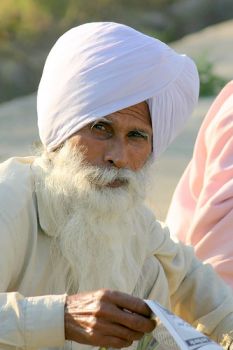Dastar - Sikh Turban
Turban is a type of headgear appearing in many cultures. One of the most famous turbans is worn by the Sikh people. They call it “dastar” or “pagri.” All Amritdhari (baptized) Sikhs must wear a dastar. For the Sikhs a dastar is much more than an ordinary headgear. Dastar is a symbol of faith, honour, courage and self-respect.
 Sikh man wearing dastar
Sikh man wearing dastar
Very important factor why the Sikhs wear turban is “kesh”or “kes.” According to kesh Sikh men allow their hair to grow freely. This is done as human hair is seen as a symbol of God's perfection. The Sikh comb their hair twice a day with a small comb called “kanga.” After being combed the hair is tied into into a knot called a “Joora” or “Rishi” knot. The knot is kept in place with kanga.
In the north of India there is a ceremony known as “Rasam Pagri” or "turban ceremony.” It is held when a father dies. In front of the people gathered to show respect to the deceased the oldest son ties a turban that belonged to his father. This act is seen as transfer of responsibilities from father to his son.
“Pag Vatauni” or "exchange of turban" is a beautiful Punjabi custom where a turban is exchanged among closest friends. The act seals their friendship. It is a bond that connect two persons, but also their families for generations.
Dastar is usually worn by men. Still there are many women who also wear it. There are several types of dastar like for example men's double Patti (Nok), Chand Tora Dhamala, Amritsar Dhamala, Basic Dhamala etc. The most popular dastar is Amritsar Dhamala. This dastar turban consists of two 35 cm wide pieces of cloth. One piece is Pavo blue. It is 5 meters long. The second piece of cloth is 11 meters long. It can be of any colour. Still those of Pavo blue and “sabz” (white) are the most popular.